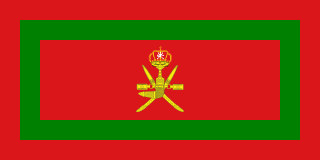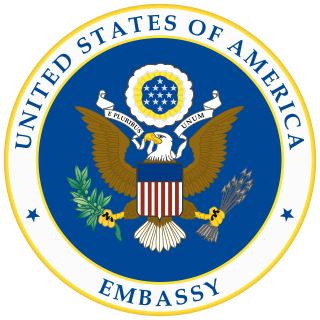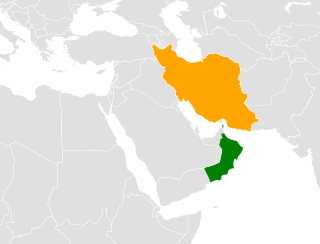
Oman, officially the Sultanate of Oman, is a country located in West Asia. It is situated on the southeastern coast of the Arabian Peninsula, and spans the mouth of the Persian Gulf. It shares land borders with Saudi Arabia, United Arab Emirates, and Yemen, while sharing maritime borders with Iran and Pakistan. The capital and largest city is Muscat. Oman has a population of nearly 4.7 million and is ranked the 124th most-populous country. The coast is formed by the Arabian Sea on the southeast, and the Gulf of Oman on the northeast. The Madha and Musandam exclaves are surrounded by United Arab Emirates on their land borders, with the Strait of Hormuz and the Gulf of Oman forming Musandam's coastal boundaries.

Oman is the site of pre-historic human habitation, stretching back over 100,000 years. The region was impacted by powerful invaders, including other Arab tribes, Portugal and Britain. Oman once possessed the island of Zanzibar on the east coast of Africa as a colony. Oman also held Gwadar as a colony for many years.

The Sultanate of Muscat and Oman, also known briefly as the State of Muscat and Oman during the rule of Taimur bin Feisal, was a sovereign state that encompassed the present-day Sultanate of Oman and parts of present-day United Arab Emirates and Pakistan, in the second half of the 19th century and 20th century. Ruled by the Busaid dynasty, it was established as a result of the partition of the Omani Empire upon the death of its last ruler Said bin Sultan. The Sultanate transitioned into a new form of government after the palace coup of 23 July 1970 in which the sultan Said bin Taimur was immediately deposed in favor of his son Qaboos bin Said.

The dynamic between the League of Arab States and the Islamic Republic of Iran has been ambivalent, owing to the latter's varying bilateral conduct with each country of the former. Iran is located on the easternmost frontier of the Arab League, which consists of 22 Arab countries and spans the bulk of the Middle East and North Africa, of which Iran is also a part. The Arab League's population is dominated by ethnic Arabs, whereas Iran's population is dominated by ethnic Persians; and while both sides have Islam as a common religion, their sects differ, with Sunnis constituting the majority in the Arab League and Shias constituting the majority in Iran. Since Iran's Islamic Revolution in 1979, the country's Shia theocracy has attempted to assert itself as the legitimate religious and political leadership of all Muslims, contesting a status that has generally been understood as belonging to Sunni-majority Saudi Arabia, where the cities of Mecca and Medina are located. This animosity, manifested in the Iran–Saudi Arabia proxy conflict, has greatly exacerbated the Shia–Sunni divide throughout the Muslim world.

The Persian Gulf Residency was a subdivision of the British Empire from 1822 until 1971, whereby the United Kingdom maintained varying degrees of political and economic control over several states in the Persian Gulf, including what is today known as the United Arab Emirates and at various times southern portions of Iran, Bahrain, Kuwait, Oman, and Qatar.

The Treaty of Seeb was an agreement reached between the sultan of Muscat, Taimur bin Feisal, and the Imamate of Oman on 25 September 1920. The treaty granted autonomy to the imamate in the interior of Oman but recognized the sovereignty of the Sultanate of Muscat. The treaty was named after Seeb (as-Sib), a coastal town in present-day Oman.

The House of Busaid, also known as Al Said dynasty, is the current ruling royal house of the Oman, and former ruling royal house of the Omani Empire (1744–1856), Sultanate of Muscat and Oman (1856–1970) and the Sultanate of Zanzibar (1856–1964). It was founded by Ahmad bin Said al-Busaidi, ruler of Oman and its east African territories at the time.

India–Oman relations are foreign relations between the Republic of India and the Sultanate of Oman. India has an embassy in Muscat, Oman. During British rule in India, Bombay presidency controlled Oman for the British Empire. An Indian consulate was opened in Muscat in February 1955 which was upgraded to a consulate general in 1960 and later into a full-fledged embassy in 1971. The first ambassador of India arrived in Muscat in 1973. Oman established its embassy in New Delhi in 1972 and a consulate general in Mumbai in 1976. India and Oman have had trade and people-to-people ties for several millennia. Oman is home to a large Indian expatriate community and for Oman, India is an important trading partner. Politically, Oman has been supportive of India's bid for permanent membership of the United Nations Security Council.

The relations between the United Kingdom and Oman are strong and strategic.

The Jebel Akhdar War, also known as the Jebel Akhdar Rebellion or the Oman War, broke out in 1954 and again in 1957 in Oman, as an effort by the local Omanis in the interior of Oman led by their elected Imam, Ghalib al-Hinai, to protect the Imamate of Oman from the occupation plans of Said bin Taimur sultan of Muscat and Oman, backed by the British government, who were eager to gain access to the oil wells in the interior lands of Oman. Sultan Said received direct financing to raise an armed force to occupy the Imamate of Oman from Iraq Petroleum Company (IPC), a consortium of oil companies that was majorly owned by what is known today as Royal Dutch Shell, Total, ExxonMobil and British Petroleum (BP); the latter was majority-owned by the British government.

Oman–Yemen relations refer to bilateral relations between the southern Peninsular Arab nations of Oman and Yemen. The two countries share a 294 km border. Both Oman and Yemen were part of the Persian Empire, and later the Umayyad and Abbasid caliphates. Yemen has an embassy in Muscat. Oman has an embassy in Sana'a. Both countries are members of the Arab League and Organisation of Islamic Cooperation.
Edmund Roberts was an American diplomat. Appointed by President Andrew Jackson, he served as the United States' first envoy to the Far East, and went on USS Peacock on non-resident diplomatic missions to the courts of Cochinchina, Thailand ("Siam") and Muscat and Oman during the years 1832–6.
The Treaty of Amity and Commerce between His Majesty the Magnificent King of Siam and the United States of America, or Roberts Treaty of 1833, was the first treaty between the United States and an Asian nation.

The Foreign Ministry is the government body in the Sultanate of Oman responsible for organising and directing Oman's relations with other countries and with regional and international organisations.

The Embassy of the United States in Bangkok is the diplomatic mission representing the United States in Thailand. At 11 acres, the embassy is the fourth largest US diplomatic mission, after Baghdad, Yerevan, and Beijing. Robert F. Godec is the current US Ambassador to Thailand.

The Omani Empire was a maritime empire, vying with Portugal and Britain for trade and influence in the Persian Gulf and Indian Ocean. After rising as a regional player in the 18th century, the empire at its peak in the 19th century saw its influence or control extend across the Strait of Hormuz to modern-day Iran and Pakistan, and as far south as Cape Delgado. After the death of Said bin Sultan in 1856 the empire was divided between his sons into two sultanates, an African section ruled by Majid bin Said and an Asian section ruled by Thuwaini bin Said.

Iran–Oman relations are bilateral relations between Oman and Iran. The two countries currently share diplomatic and economic ties dating back to the Pahlavi period. Oman considers Iran not to be a threat perceived by the other Arab states of the Persian Gulf. Both countries are members of the Organisation of Islamic Cooperation, the Non-Aligned Movement and the Group of 77. Iran has an embassy in Muscat whilst Oman has an embassy in Tehran.

Oman–Syria relations refer to the relationship between the Sultanate of Oman and the Syrian Arab Republic. Oman has an embassy in Damascus; while Syria has an embassy in Muscat. Both are members of the Arab League, and despite the ongoing civil war occurring in Syria, Oman has not closed its embassy in Syria and both countries maintain diplomatic relations, in sharp contrast to other Arab states of the Persian Gulf who have cut off diplomatic ties with Syria and closed their embassies.
John Russell Countryman, stage name Johnnie Russell, is an American former child actor and retired career officer for the United States Foreign Service.

Oman–Tanzania relations are the diplomatic relations between Oman and Tanzania. The Sultanate of Oman has one of the oldest historical relationship with communities in Tanzania, namely in Zanzibar. Oman is the only country outside Africa where Swahili is spoken as a first language, and its people have blood relations with the people of Tanzania.




















